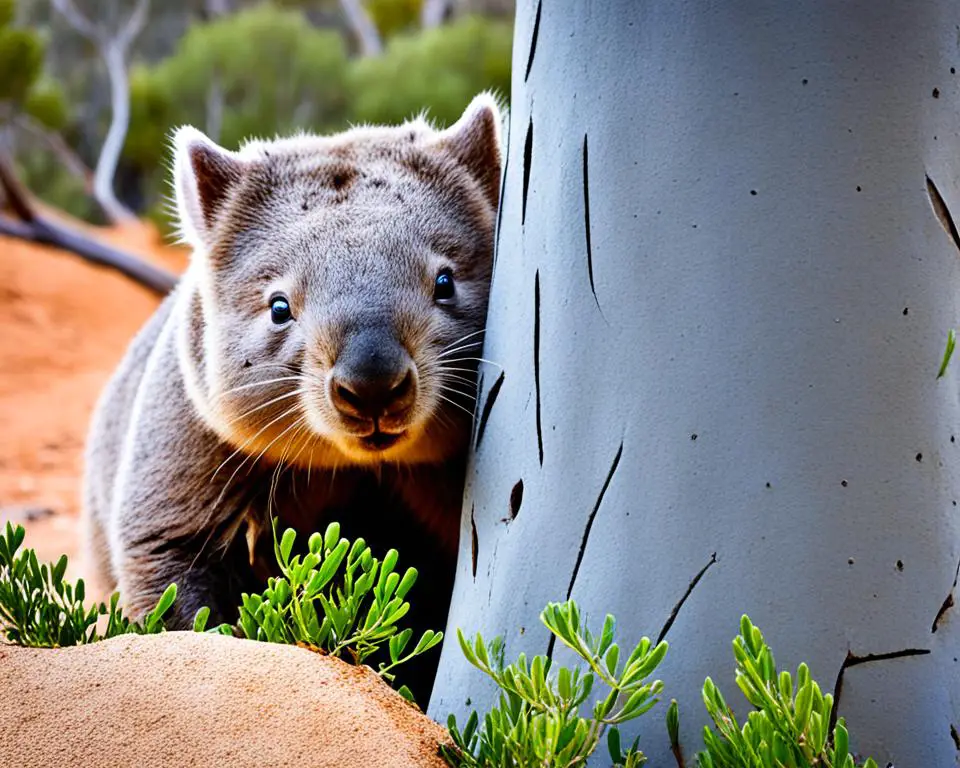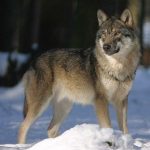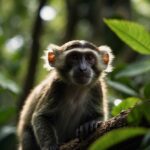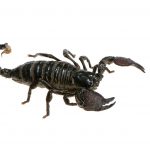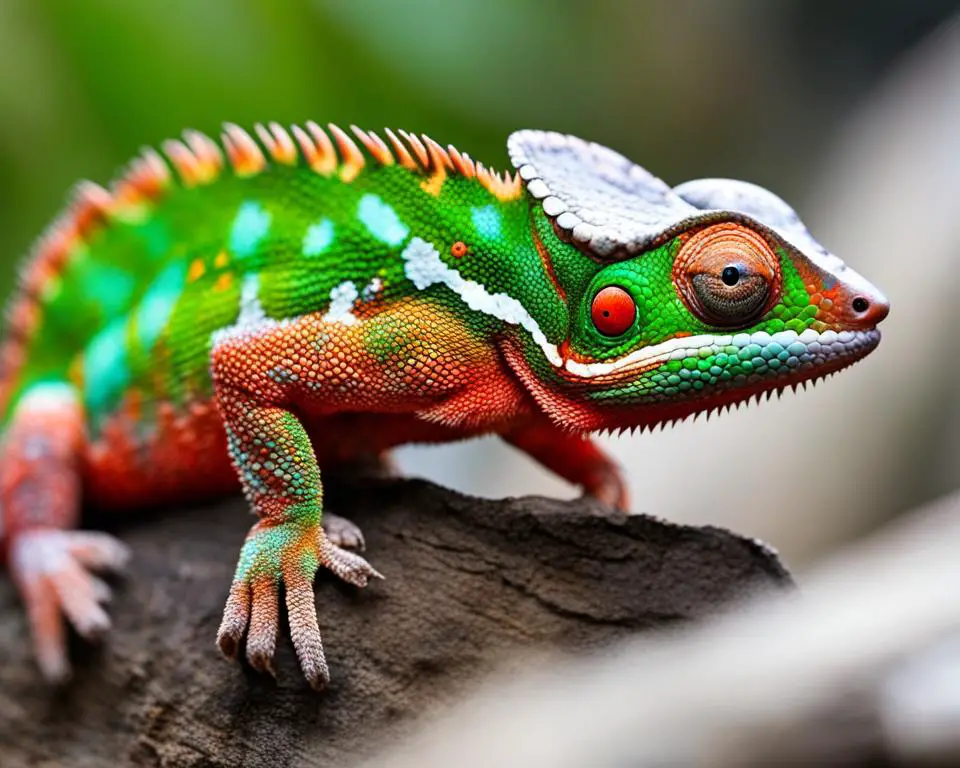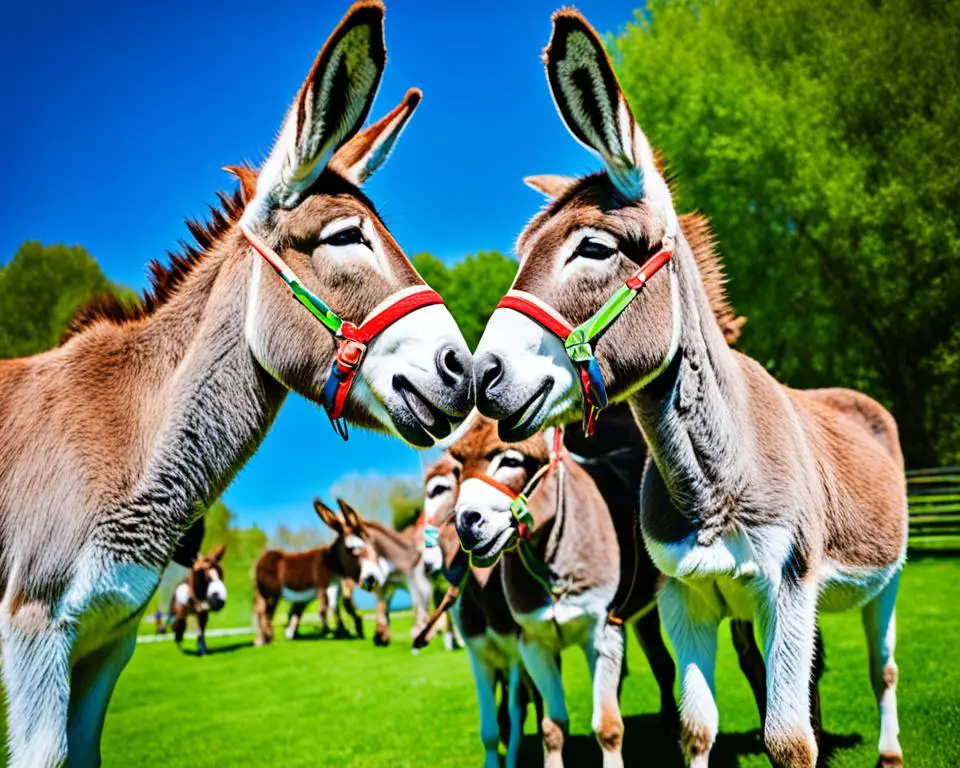Have you ever been mesmerized by the eccentric charms of Australia’s wildlife? Among the vast array of marsupials that call the land down under home, wombats stand out with a set of quirky animal facts that could steal the show. These stout, nocturnal creatures captivate nature lovers with their fascinating behaviors and distinct physical traits.
Who could imagine that an animal could naturally produce cube-shaped poop? Or that their closest living relative is the adorable koala? Your curiosity about nature will be richly rewarded as you discover the wonders of wombats. With ever-growing teeth, a slow metabolic rate perfect for their arid habitats, and the unusual but effective defense techniques against predators, wombats exemplify the odd and the awe-inspiring. Buckle up for a deep dive into the world of wombats, the extraordinary marsupials that embody Australia’s unique wildlife legacy.
The Quirky Cube-Shaped Wombat Poop
When you think of wildlife wonders, perhaps the most peculiar and unique animal trait that might cross your mind is the cube-shaped poop of the wombat. Yes, you read that correctly—wombats are the master sculptors of the animal kingdom, excreting feces that are oddly cubic in form. But it’s not just a curious oddity; it serves a important functional purpose in the life of these marsupials.
The reason behind this unique animal trait is all about territory. Wombats use their cube-shaped poop to mark the boundaries of their domain, placing these geometrical droppings on rocks and logs where they are less likely to roll away. This territorial behavior ensures that other wombats can clearly see, and smell, who claims the terrain they tread on.
| Features | Details |
|---|---|
| Shape | Cube-like |
| Purpose | Territorial marking |
| Placement | On elevated structures (rocks, logs) |
| Advantage | Prevents rolling, maintains boundary signals |
This pointed prowess in poop is thanks to the wombat’s digestive system, which is not only efficient but has evolved to produce feces that defy the usual expectations—we’re far from the spherical or tapered ends commonly associated with wombat feces. Next time you’re marveling at the natural world’s wonders, remember the wombat and its peculiar, but purposeful, excretions.
Defensive Techniques of Wombats: More Than Just a Cute Face
When you catch sight of a wombat, you might be beguiled by their innocent, cute appearance. But do not be deceived; wombats are equipped with remarkable wombat defense strategies, capable of thwarting even the most determined predators. Their charm disguises a rugged survival instinct and an uncanny ability to safeguard their domain—particularly, their burrow.
A wombats’ rear is not just for sitting; it’s a crucial part of their defense apparatus. Underneath that cuddly facade lies a posterior largely made of cartilage, tough and almost impenetrable. Think of this as their natural armor against scratches and bites that would otherwise harm them. But how exactly does this work in action?
Upon sensing a threat, wombats don’t stand and fight. Instead, they opt for strategic retreat into their burrows—complex, underground safe houses that they call home. It’s here that the wombat’s backside truly shines. In a remarkable move, they use their rumps to seal off the entrance, denying entry to unwelcome visitors. And if a predator persists, the pressurized encounter with a wombat’s rump has the potential to crush its skull—truly an effective deterrent for any lurking danger.
| Defense Mechanism | Description | Advantages |
|---|---|---|
| Cartilage-Enforced Rump | Acting as a shield when blocking the burrow’s entrance | Resistant to predators’ teeth and claws |
| Burrow Blockage | Using their behinds to prevent predators from entering | Can incapacitate or repel even the most robust creatures |
| Strategic Retreat | Retreating into their burrows to avoid conflict | Utilizes the familiar terrain to the wombats’ advantage |
So, while wombats might spend their days lazily lounging or gently grazing, when push comes to shove, they are more than capable of protecting themselves and their young. The next time you envision the homely wombat, remember that beneath their soft exterior lies the heart (and the butt) of a warrior, masterfully adapted to life in the wild Australian landscapes.
Surprising Relatives: The Wombat-Koala Connection
As you delve into the world of wombats, you’ll unearth a little-known fact that links these ground-dwelling mammals to the tree-loving koalas: they are much closer relatives than their distinct appearances suggest. The wombat relatives in the animal kingdom are not limited to creatures burrowing in the underbrush but extend upward to the eucalyptus dwellings of their marsupial cousins.
Physical Similarities and Distinctive Features
While at first glance, the koala-wombat relationship may seem far-fetched, a closer observation reveals shared characteristics deeply embedded in their biology. Both wombats and koalas carry the hallmark of marsupials—the marsupial pouch—but they exhibit it in a distinctive manner that enhances their respective ways of life.
Importance of Backward-Facing Pouches
The backward-facing pouch is perhaps the most intriguing similarity between koalas and wombats. For wombats, their pouch orientation is a critical evolutionary adaptation, serving as a protective measure to keep the contents of the pouch—most preciously, their young—free from debris while they dig through the earth.
Understanding the marsupial pouch functionality provides insight into how these creatures have mastered their environments. It is not only a cozy nurturing space for their offspring but also a remarkable sign of convergence—a silent nod to a common ancestry deep in the Australian ecosystem. Indeed, the wombat relatives narrative is a tale of adaptation and survival, weaving through the thickets and the treetops with equal dexterity.
Diversity of Wombat Species Across Australia
Australia’s vast landscapes are the nurturing grounds for a variety of unique fauna, including the charming and elusive wombat species. As you explore the countryside, you may be fortunate enough to encounter the most commonly seen Bare-Nosed Wombat, widely recognized by its lack of facial hair and distinctive nose. But Australia’s diversity doesn’t end there; the ecosystem also boasts the presence of the Southern Hairy-nosed Wombat and the critically endangered Northern Hairy-nosed Wombat, each with its own unique features and adapted habitats.
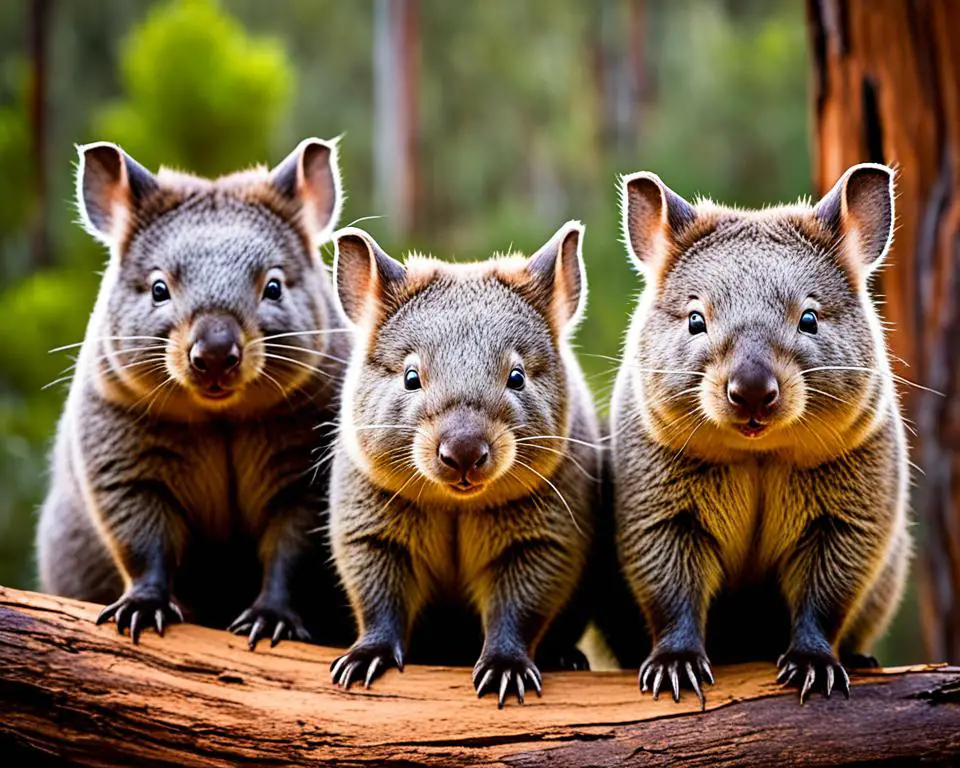
These three wombat species, although similar in many behaviors and traits, have each carved out their own niche across the continent. Their presence plays a significant role in maintaining the ecological balance and diversity of the regions they inhabit. Let’s take a closer look at where these intriguing animals fit into Australia’s rich tapestry of life.
| Wombat Species | Physical Traits | Preferred Habitat | Conservation Status |
|---|---|---|---|
| Bare-Nosed Wombat | Less fur on the nose, robust body | Forests, coastal shrublands, and heath | Common |
| Southern Hairy-nosed Wombat | Softer, silkier fur with hairy nose | Semi-arid grasslands, woodlands | Near Threatened |
| Northern Hairy-nosed Wombat | Soft fur, large ears, very hairy nose | Restricted to protected areas | Critically Endangered |
With the Bare-Nosed Wombat trotting throughout more temperate regions, the Southern Hairy-nosed Wombat foraging in arid zones, and the Northern Hairy-nosed Wombat clinging to survival in protected sanctuaries, the struggle for existence varies widely among these species. You, as an admirer of nature, can delight in knowing that such distinct marsupials contribute uniquely to the fascinating wildlife narrative of Australia.
Wonderous Group Dynamics: A Wisdom of Wombats
Delve into the extraordinary world of wombats and you’ll uncover the charming term for a wombat group: a wisdom of wombats. This poetic moniker hints at the communal intelligence of these delightful animals and joins the list of whimsical and thoughtful animal collective nouns that pepper the Australian vernacular. The social life of wombats might seem reclusive to the untrained eye, but it’s structured within a well-defined home range nestling their complex underground habitats.
Before visiting the underground complexes of these affectionate creatures, let’s appreciate the breadth of creativity found in the other animal collective nouns famously coined for Australian fauna:
Other Unique Australian Animal Collective Nouns
- A mob of kangaroos
- A paddle of platypuses
- A conspiracy of ravens
- An implausibility of gnus
Now, turning our gaze back to wombats, we explore their social tapestry:
The Social Structure of Wombat Communities
Although wombats are often considered solitary creatures, they exhibit fascinating, if not extensively studied, social behaviors. ‘Wisdom’ may entail a loose affiliation where overlapping territories are the norm rather than exception among wombats. These structured territories form intricate communities within the Australian landscape, each with their preferred foraging grounds and network of burrows.
| Wombat Community | Key Characteristics | Important Behavioral Aspect |
|---|---|---|
| Foraging Grounds | Areas rich in grasses and roots | Food sourcing is a communal activity |
| Burrow Networks | Large, elaborate underground habitats | Often shared among the ‘wisdom’ during emergencies |
| Territorial Markings | Visual and olfactory signals including unique cube-shaped feces | Communicate boundaries and promote cohabitation |
A ‘wisdom of wombats’ thus navigates the delicate balance between individualism and shared living spaces, marking their territory but also aiding the community in times of need. Beyond their cute façade, wombats sustain complex communal bonds manifested in, but not limited to, the elaborate architecture of their shared homes. There lies the understated sophistication and wisdom of wombats—a treasure hidden beneath the surface of the Australian bushland.
Record-Breaking Wombats: From Weight to Longevity
Imagine encountering a marsupial that weighs as much as an adult human. That’s exactly how hefty the heaviest wombat on record was—an astounding 38 kilograms (about 84 pounds)! There’s something truly remarkable about the sheer scale and wombat lifespan that punctuates the story of these Australian natives.
When discussing record-breaking wombats, one cannot overlook Patrick, the Bare-Nosed Wombat, who tipped the scales as the heaviest wombat known. Residing at Ballarat Wildlife Park, this marsupial celebrity also set the bar high for longevity, becoming the oldest wombat recorded, living up to 32 years before passing away peacefully. Patrick wasn’t just an oversized cuddly creature; he was a testament to the potential longevity of the species—far outstripping the average wombat lifespan in the wild, which is usually between 5 and 15 years.
You might be surprised to learn that these weights and ages aren’t just outliers; they’re significant indicators of the wombat’s robustness and their adaptability to both captivity and wild environments. A deeper look into the lives of these wombats reveals a fascinating journey of survival and adaptability.
| Notable Record | Detail | Insight |
|---|---|---|
| Heaviest Wombat | Patrick the Bare-Nosed Wombat at 38kg | Equivalent to average weight of an adult human |
| Oldest Wombat | Patrick lived to 32 years | Exceeds wild wombats’ average lifespan by over a decade |
| Wombat Lifespan | Typically 5-15 years in wild | Longevity can be significantly extended in captivity |
Whether waddling through Australian bushlands or living under the protection of wildlife sanctuaries, wombats like Patrick continue to be subjects of fascination and affection, propelling our admiration for the natural world. Remember, when you’re next marvelling at Australia’s wildlife, there’s more to wombats than meets the eye—they might just hold another record waiting to be discovered by avid wildlife enthusiasts like you.
Wombats: The Athletic Marsupials of the Animal Kingdom
Despite their cuddly appearance and stout stature, wombats possess an unexpected athletic ability that may surprise you. Hidden beneath their fur is a creature of remarkable agility and power. Let’s take a closer look at the wombat speed and discover just how swift these marsupials can be.
Comparison with Human Speed
Would you believe that a wombat can give some humans a run for their money over short distances? It’s a fact—these animals can reach speeds of up to 40 km/h, showing off their impressive animal agility. This means that in the animal kingdom Olympics, wombats are closing in on some of the fastest human sprinters, such as Usain Bolt, who peaks at around 47 km/h.
Adaptations for Fast Movements
What allows a wombat to sprint at such astonishing speeds? It comes down to their athletic ability, built into their very anatomy. With strong, muscular hind legs and a compact body, wombats are engineered for bursts of high-velocity movement. This enables them to dash into their burrows or evade danger with surprising quickness. Indeed, beneath that placid exterior lurks the heart of a competitive sprinter, ready to unleash its pace upon the world.
| Wombat Characteristic | Contribution to Speed |
|---|---|
| Muscular Hind Legs | Provide powerful propulsion |
| Compact Body | Enhances aerodynamics and movement efficiency |
| Low Center of Gravity | Improves stability and balance during high-speed runs |
When you next spot a wombat, remember that there is more to these marsupials than their calm demeanor suggests. Their athletic ability is a prime example of nature’s way of molding creatures to be multifaceted survivors, combining cuteness with the capacity for rapid, agile movement. So the next time a wombat catches your eye, consider the swift, athletic prowess contained within that seemingly leisurely saunter.
Adaptations for Survival: Wombat’s Ever-growing Teeth
As you explore the lifestyle of wombats, it’s not just their cube-shaped poop or burrowing skills that catch the eye. What’s particularly fascinating is their dental anatomy; specifically, wombat teeth are designed for endurance. Adaptations for survival in the animal kingdom often include some remarkable traits, and the continuous growth of a wombat’s dentition is no exception, tailor-made for their herbivore diet.
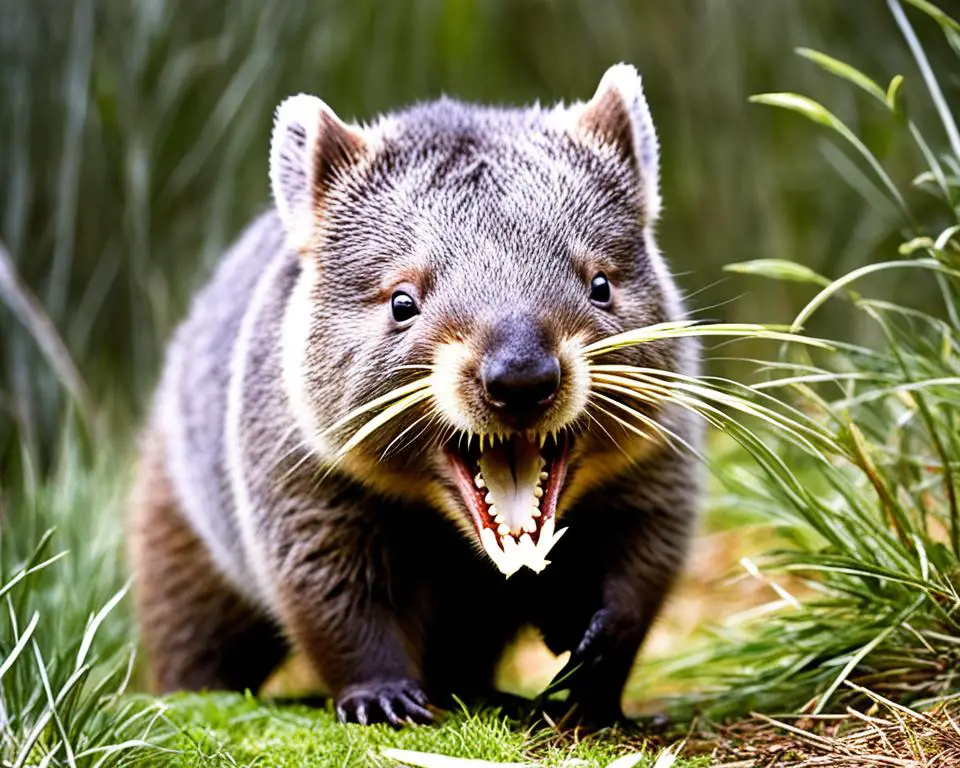
Dietary Habits and Teeth Maintenance
Understanding how wombats maintain their dental health takes us to their fierce munching of tough vegetation. A steady diet of grasses, roots, and even bark requires hard-wearing teeth to efficiently break down the fibrous material, ensuring these marsupials get the nutrients they need to thrive. Wombats have teeth that resemble those of rodents, not only for their shape but also for their persistent growth.
Why Do Their Teeth Continuously Grow?
So why do wombats have teeth that won’t stop growing? It’s a clear case of form following function. Their incisors must withstand a considerable amount of abrasion from chewing and grinding their meals. For wombats, continuously growing teeth aren’t a dental dilemma, but rather an evolutionary must-have for their daily grazing and foraging. Without this unique adaptation, wombats’ teeth would quickly wear down to nubs, rendering them unable to process their fibrous meals efficiently.
| Wombat Teeth Feature | Function | Adaptation Benefit |
|---|---|---|
| Continuous Growth | Compensates for wear and tear | Allows wombats to consume tough vegetation without teeth wearing down |
| Sharp Incisors | Effective cutting of food | Slices through stubborn roots and grasses with less force |
| Strong Jaw Muscles | Powerful grinding and chewing | Processes rough dietary components, promoting digestive efficiency |
The next time you’re charmed by a wombat’s small, whiskered face, spare a thought for the impressive set of chompers that keep these creatures well-adapted to their constant nibbling nature. Their remarkable continuous growth is a key to survival in the rugged Australian landscape, serving as an impressive testament to the intricate relationship between form, function, and diet in the world of marsupials.
The Slow Digestive Process of Wombats
Wombats are often celebrated for their adorable appearance, but their internal workings harbor an equally intriguing aspect: a notably slow metabolism. The wombat digestion process spans an impressive duration—food can take up to two weeks to journey through their digestive system. While a leisurely digestive pace might seem inefficient, for wombats, it plays a pivotal role in their survival, particularly in the arid environments they frequent.
Benefits of a Slow Metabolism
Why would a creature benefit from such a slow metabolic rate? To start, a slow metabolism helps wombats conserve vital energy. In the vast, often harsh landscapes of Australia, food can be scarce. By digesting food slowly, wombats maximize nutrient absorption, turning every leaf and blade of grass into a valuable resource. This strategy means less energy expended on constant foraging and more reserved for essential activities.
How Digestion Aids in Water Conservation
Aside from energy conservation, the wombat’s digestive system is marvelously designed for water conservation—a crucial adaptation for life in often parched conditions. During their extended wombat digestion period, their bodies can extract nearly every drop of water from their food. This efficiency reduces the need for wombats to find water sources, a significant advantage during droughts or in dry seasons.
| Adaptation | Function | Benefit to Wombats |
|---|---|---|
| Extended Digestion Time | Slow nutrient absorption | Maximizes energy and nutrient use with minimal food |
| Efficient Water Extraction | Removes water from food during digestion | Decreases dependency on direct water sources |
| Low Metabolic Rate | Reduces energy expenditure | Survival advantage in resource-scarce environments |
Your appreciation for the humble wombat might grow when you consider how wonderfully adapted they are to their environment. The next time you encounter information on these marvellous marsupials, remember that their slow pace extends beyond their meandering walk—it’s a key part of their anatomy and lifestyle that helps them thrive in the Australian wild.
Fun Facts About Wombats: The Second Largest Marsupial
When you explore the fascinating world of Australian marsupials, you’ll quickly discover that the second-largest marsupial, the wombat, holds a special place in both the environment and the hearts of animal enthusiasts. Averaging about a meter in length and tipping the scales at a robust 40 kilograms, wombats may be overshadowed in size only by their distant relative, the Red Kangaroo, the largest of all marsupials.
Unfolding the pages of their evolutionary story leads us to the Diprotodon, an ice-age giant that mirrors the wombat in many ways but on a far grander scale. Imagine an herbivorous behemoth as tall as 2 meters wandering the ancient Australian landscape—this was the Diprotodon, an ancestor to modern wombats that neatly ties today’s small-sized diggers to their colossal prehistoric counterparts.
| Marsupial | Average Size | Known For |
|---|---|---|
| Wombat | 1 meter in length, up to 40 kg | Second-largest living marsupial |
| Red Kangaroo | Up to 1.8 meters tall, over 90 kg | Largest living marsupial |
| Diprotodon | Approx. 2 meters tall, up to 2,800 kg | Largest known marsupial ever |
The present-day wombat, while not nearly as intimidating in size as the Diprotodon, still carries a significant presence as a keystone species in Australia’s ecosystem. By understanding their history and biological heritage, your perspective on these intriguing marsupials may grow, revealing a creature connected to a past where mammals of incredible magnitude once roamed.
As you observe these creatures digging through the terrain, remember the extraordinary lineage they represent—one of adaptation, survival, and the fascinating evolutionary journey of marsupials. The Diprotodon may be gone, but its lineage persists, encapsulated in the endearing form of the wombat, the enduring second-largest marsupial living in Australia’s diverse habitats today.
Wombats’ Nocturnal Adventures and Daytime Retreats
Once the sun dips below the horizon, the Australian bushland hums with the nocturnal behavior of wombats. These furry marsupials emerge from their burrows to embark on nightly escapades, engaged in a relentless quest for sustenance that matches their particular dietary needs. Their evening foray is not only essential for foraging but is also a showcase of their intriguing nocturnal lifestyle.
Foraging Behavior and Diet
As you gaze into the moonlit wilderness, you might just catch the silhouette of a wombat, methodically grazing on the tender shoots of grasses and the fibrous roots that comprise their herbivorous diet. This vital activity fills the quiet night with a sense of purpose for these creatures, as they meticulously munch their way through the underbrush, fueled by the need to support their robust frame and energy demands.
Consisting almost exclusively of vegetation, the wombat diet is a testament to these animals’ ability to thrive on what the Australian terrain offers. Despite their rough-appearing exterior, wombats possess a finely tuned digestive system that efficiently processes this tough, fibrous diet, harmonizing seamlessly with their burrow lifestyle.
The Importance of Sunbathing
Contrary to their nightly exploits, daytime sees a different side of wombat behavior. When they aren’t resting in the security of their meticulously dug-out homes, wombats can occasionally be found sunbathing. These sun-soaked moments provide warmth and aid in regulating their body temperature, especially during the chillier days, highlighting the wombat’s innate ability to coexist with the capricious nature of their surroundings.
Moreover, sunbathing serves more than just a thermal function for wombats. This behavior is also an opportunity for rest and rejuvenation, allowing them to absorb the sun’s energy, preparing for the next nocturnal adventure. It’s during these quiet daytime intervals that wombats retreat to the familiarity of their burrows, reaffirming their symbiotic relationship with the environment and their burrow lifestyle.
Whether foraging by night or resting by day, wombats perfectly encapsulate the essence of survival within the diverse and vibrant tapestry of Australian wildlife. Their routine is a delicate dance of nocturnal activities paired with the solace found in the daytime serenity of their burrows, each aspect critical to the other, punctuating the unique existence of the native wombat.
The Complex Burrow Systems of Wombats
Dive into the underground world of wombat warrens, and you’ll uncover a network of burrow habitats that are much more than just simple dug-out homes. These elaborately constructed tunnels, extending beyond 200 meters in length, provide not only refuge for wombats but also protection for an array of other wildlife.
Wombats are master architects of subterranean design, with their warrens comprising a series of interconnected tunnels and chambers each serving a unique purpose. Let’s unearth how these burrow systems support their lifestyle and offer sanctuary to other creatures.
- Temperature Regulation: The intricate design of wombats’ burrows ensures a stable microclimate, remaining cooler during the heat of the day and warmer during the cold nights.
- Protection from Predators: The complexity and depth of warrens act as a defense mechanism, deterring predators and ensuring the wombats’ safety.
- Fire and Heat Shield: During bushfires, the underground networks provide an essential haven not only for wombats but for other species as well.
Envision a wombats’ warren as a multilevel ecosystem in itself—an intricate series of burrow habitats that demonstrate incredible resilience and adaptation. It’s not only a home but a sanctuary in times of environmental stress. Other animals, from small marsupials to reptiles, often seek refuge within these structures, safe from the rampant wildfires above.
As protectors of the land and inadvertent conservationists, wombats play a critical role through the creation of these warrens, benefiting Australia’s biodiversity. So, the next time you think of a wombat’s cozy abode, remember the dug-out homes are feats of engineering—cornerstones of survival for a host of native species.
Let’s delve into some of the specific features that make wombat burrow systems so essential:
| Feature of Warrens | Benefit to Wombats | Benefit to Other Wildlife |
|---|---|---|
| Multiple Entrances | Easy access and quick escape from threats | Various species can use different entry points simultaneously |
| Extensive Depth and Length | Stable climate control and space to grow | Shelter during extreme temperatures and natural disasters |
| Chambers and Nooks | Separate spaces for sleeping and rearing young | Hideouts for smaller creatures avoiding predators |
With these insights, you can begin to appreciate the wombat not simply as a solitary creature, but as a key environmental engineer, shaping the land beneath our feet and providing a lifeline to a myriad of species when disaster strikes.
Giant Wombats and Evolutionary History
As you delve into the annals of prehistoric Australia, you encounter the Diprotodon, a magnificent creature that once roamed the continent. These giant wombats, the largest marsupials to have ever lived, were emblematic of the Australian Ice Age fauna. The legacy of these colossal beings provides a fascinating glimpse into the evolutionary history of today’s smaller marsupials.
The Diprotodon species, known informally as giant wombats, was a group of Ice Age marsupials that marked the peaks of terrestrial mammalian biodiversity in ancient Australia. These marsupials were not merely large; they were the size of modern rhinoceroses, with some believed to have weighed over a staggering 2,800 kilograms. As you imagine these titanic ancestors lumbering through the prehistoric bush, it’s hard not to be awed by their sheer stature and prominence in the natural history of the continent.
Modern wombats, which are much more petite relatives of these ancient giants, demonstrate how much has changed over millennia. The ancient Diprotodon, which is both akin and grandiose compared to their descendants, illustrates the incredible plasticity of nature and the evolutionary shifts that can occur over the eons.
There is evidence to suggest that these giant wombats did not go unrecognized by ancient human populations. It’s believed that early Australians may have encountered the Diprotodon, and their interactions—possibly even hunting—could have played a role in the stories and rock art that span generations.
Consider, for a moment, the tremendous journey wombats have undertaken throughout history—from the gargantuan Diprotodon of the Ice Ages to the endearingly robust wombats of today. It’s a transition that encapsulates survival, adaptation, and the shifting tapestry of life on Earth.
| Characteristic | Diprotodon | Modern Wombat |
|---|---|---|
| Estimated Weight | Up to 2,800 kg | Up to 40 kg |
| Height | Approximately 2 meters | Usually under 1 meter |
| Interaction with Humans | Possible hunting by ancient populations | Modern conservation efforts |
| Time Period | Ice Age | Contemporary |
Your knowledge expanded, you recognize how Diprotodon and Ice Age marsupials are not mere footnotes but vital chapters in the evolution of the Australian landscape. As significant as any living marsupial today, they serve as a powerful reminder that what roams the Earth now is but a snapshot in the vast album of life—a chapter in the ongoing story that is evolution.
Unique Features of Wombats: From Pouches to Tough Rumps
Discover the unique adaptations of wombats that have intrigued scientists and animal enthusiasts alike. Found exclusively within these adorable marsupials are certain anatomical features that have enabled them to thrive in the diverse and often harsh environments of Australia. Consider the incredible design of marsupial pouches and the ingenious wombat defenses that together showcase the evolutionary marvels of these creatures.
Unlike most other marsupials, wombats possess backward-facing pouches. The primary purpose of this intriguing orientation is to protect their young, known as joeys, from getting buried in soil as their mothers engage in extensive digging activities. This design acts like a shield, ensuring that the pouch remains free of dirt and debris, which could potentially harm the sensitive joeys as they develop.
Meanwhile, stepping beyond their nurturing side, wombats are also well-equipped for defense. With their tough rumps that consist largely of cartilage, they employ a rather unique method of warding off predators. When a threat approaches, wombats retire swiftly into their burrows and use their reinforced backsides to block the entrance, preventing any predator from getting through. It’s an exceptional defensive strategy that turns their vulnerability into a strength.
| Unique Feature | Description | Function |
|---|---|---|
| Backward-Facing Pouch | Locates the pouch opening towards the mother’s rear | Keeps the young safe from dirt during digging |
| Cartilage-Enforced Rump | Tough and resistant backside of the wombat | Blocks burrow entrances to deter predators |
| Protective Burrow Entrances | Wombat quickly dives and blocks with tough rump | Acts as a shield against predator invasion |
The wombats’ defenses and their backwards pouch serve not just as mere quirks of nature but rather as remarkable evolutionary solutions to the challenges presented by their environment. So, the next time you spot a wombat or read about them, picture these amazing marsupial pouches and visualize the resilient rump in action—two of the most unique adaptations making wombats the ultimate survivalists of the marsupial world.
Conclusion
As we reach the end of our wombat journey, it’s evident that these charming marsupials are not only fascinating and playful members of the wildlife kingdom, but also vital to Australia’s natural heritage. Through our exploration, we’ve learnt about their remarkable cubed feces, their backside-defensive prowess, and the surprising wombat-koala kinship. Reflecting on their diverse habitats and biological uniqueness, it’s clear that wombats are more than mere animals—they are ecological engineers adept at shaping the environment in understated yet profound ways.
Conservation Efforts and the Future of Wombats
While wombats may seem robust and resilient, the truth is that some species, particularly the Northern hairy-nosed wombat, face critical endangerment due to challenges like food shortages and droughts. Uniting in wombat conservation efforts gives animal enthusiasts and wildlife protectors hope, as we’ve already seen heartening progress in bringing their populations back from the brink. Initiatives promoting protection of wombat habitats and restoring ecosystem balance underscore the potential for these unique creatures to have a thriving future. It is the dedication and care from each one of us that will write the next chapter for wombats in the wild.
Join the Wombat Fan Club: How to Appreciate and Help Protect These Unique Creatures
You can transform your admiration into action. Joining the wombat fan club is more than celebrating their adorable quirks; it’s about active engagement in wildlife protection. Whether you choose to support a local wildlife park or participate in conservation programs, your efforts contribute significantly to the wellbeing of these remarkable marsupials. By educating others about the wonders of wombats and advocating for their conservation, you help ensure that future generations will continue to enjoy the unique charms of these Australian natives. So go ahead, embrace your love for wombats, and play a part in safeguarding these treasures of the animal kingdom.

